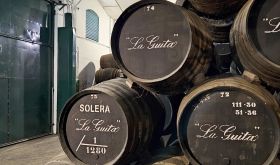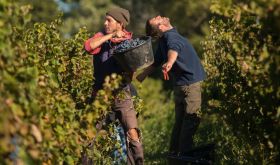I recently tasted a range of southern French whites, including some of Gérard Gauby’s trail-blazing and extremely fine examples from Roussillon and this wine, made nearby and much less expensive than his finest, stood up well to the comparison. This is a very dry, fine, tense, full-bodied white that is clearly strongly terroir-influenced but is not at all fat. There’s great impact of broad Grenache fruit on the front palate and considerable bite – a bit of astringency but no bitterness. This a white of real interest and complexity with hints of greengage fruit and and the schistous soil on which these old vines were grown. There is real potential for development here and I’d drink it any time over the next four years.
This marvel, very much in the mould of a Gauby white, can be found at £11.63 in the UK, 15 euros in Europe and $22.99 in the US. (Purple pagers can find my full tasting notes on the other wines I tasted in Some sizzlingly good southern French whites.)
Marjorie Gallet is the young woman behind Domaine Le Roc des Anges and she brings real commitment and passion to this far south west corner of France. She has about 22 ha/54 acres around the village of Montner in the upper Agly valley, that special corner of schist around Maury that once had its own special Vin de Pays des Coteaux Fenouilledes but now has to sell its wines without any really distinctive or particular name. This is where Le Soula, another wine of the week, comes from too.
This particular wine is mainly Grenache Gris with some Grenache Blanc and Maccabeu. According to UK importers Caves de Pyrene, “Marjorie Gallet uses an old vertical press to get the juice out of the thick-skinned grapes. With a gentle pressing and a very light racking off she gets both the purity and richness of the juice. The fermentation takes place without any temperature control and lasts from the end of August until early October and occasionally until April. Then the wine remains in tank and barrel for a while just to settle without batonnage or racking in order to keep the purity and spirit of the grapes.
“Montner, the name of the village, derives from Monte Negro (Montagne Noir) and is so named because of the dark schists. The soil is composed of old rotten schists (which are the best sort of schists) and traditional grape varieties dominate the cépages. These decomposed flaky schists allow excellent drainage but encourage the vines to form deep root systems. The vignoble comprises old vines of Carignan (50% of the red vines) and Grenache Gris (80% of the white vines), then Grenache Noir, Syrah and Maccabeu. The vineyards are a mosaic of 43 tiny parcels of land arranged in a variety of expositions on the north shoulder of the Forca Real, the local mountain. The first vines were planted in 1903 and 55% are between 40 and 90 years old. Densities of 4000-plants/hectare on the old vines and 7,000-10,000 on the young vines encourage competition, thereby reducing vigour.
“Everything done in the vineyard is traditional, from the use of local stone to create low walls to divide the parcels of land, all bound up in the notion of respect for the cultural heritage of the region. This is extended further into viticulture where respect for the environment is paramount. All work is based on seeking equilibrium for the vine and allowing it to find its autonomie (defined by vigour, yield, nutrition and natural defence), an essential factor in the expression of terroir. Other than leaf thinning and pruning of the vine to encourage the microclimate, operations in the vineyards are strictly non-interventionist.
“It is the light permeable soils themselves from where the wines obtain their unique texture and vibrancy. This is a work in progress, according to the vigneron; only a truly living soil will be able to liberate the essence of the terroir. In the cellar simplicity and authenticity are the watchwords. A traditional press is used, exerting the mildest of pressure, extracting limpid juice. Vinification is in concrete tanks ranging between 24 and 50hl, and the shape of the tanks and the level of the fill determine the appropriately gentle extraction. Ageing takes place in two types of containers; concrete – which exalts the aromatic purity and freshness of the wine – and wood (for about 10% of the elevage) in the form of one-to-three year old barrels.”
It was only after my tasting and the great impact this wine made on me that I remembered that this site’s old friend and prolific contributor David Schildknecht of Ohio also imported Marjorie Gallet’s wines. You can read what he has to say about her red wines in American responses to Carignan, written after I published Can Carignan ever be great? last year.
Considering how relatively limited the production of this wine must be, it is quite widely available according to winesearcher: find this wine













